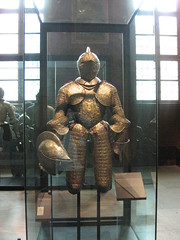Medieval Armor - The Replicas Of Ancient Body Armors
 The epitome of medieval armor lies in its exceptional structure and significant praxis. In medieval period soldiers wore it in wars and combats, so that they can defend themselves from the sudden attacks of the enemies.
The epitome of medieval armor lies in its exceptional structure and significant praxis. In medieval period soldiers wore it in wars and combats, so that they can defend themselves from the sudden attacks of the enemies.
The prime usage of medieval armors was to protect the soldiers or its wearer from the strikes of the weapons. Earlier, in Greek and Roman empires these body shells were considered as the top priority for soldiers and every knight had to wear it.
These knights are most memorized for their sophisticated armors. However, apart from the excellence of armors and their battle competence, they were also considered as the style statement.
In fact, even today most of the people around the world are awestruck with medieval armors. Many people strive to collect these historical artifacts for their home collection and rummage around for the best replicas of those medieval armors which were in those days considered as the prestigious possessions.
Owning a breastplate, early medieval helmet, axes and lots of other kinds of armors can change the entire gaze and feel of your home. All these medieval armors can be used for battle reenactments also and in various movies and shows in order to regenerate the exact feel of medieval era in the mind and heart of the viewers.
All the medieval armors are usually hand made by the well versed artisans but many of them are machine made also. The material used in the construction of the armaments is also of top quality, so that they can remain for a long time to come.
If we talk about the replicas of ancient helmets, then there are varieties of these head covering like Viking helmet, Roman helmet, French helmet, Gladiator helmet, Knight helmet, Saxon helmet etc.
If you need ancient axes then medieval axe and medieval farsa are available for your requirement. Likewise, various other kinds of medieval armors in the form of chain mail, leather, breastplate can also be purchase from various online shops.
Find the most exclusive range of medieval armor at http://www.stalloneindia.com
